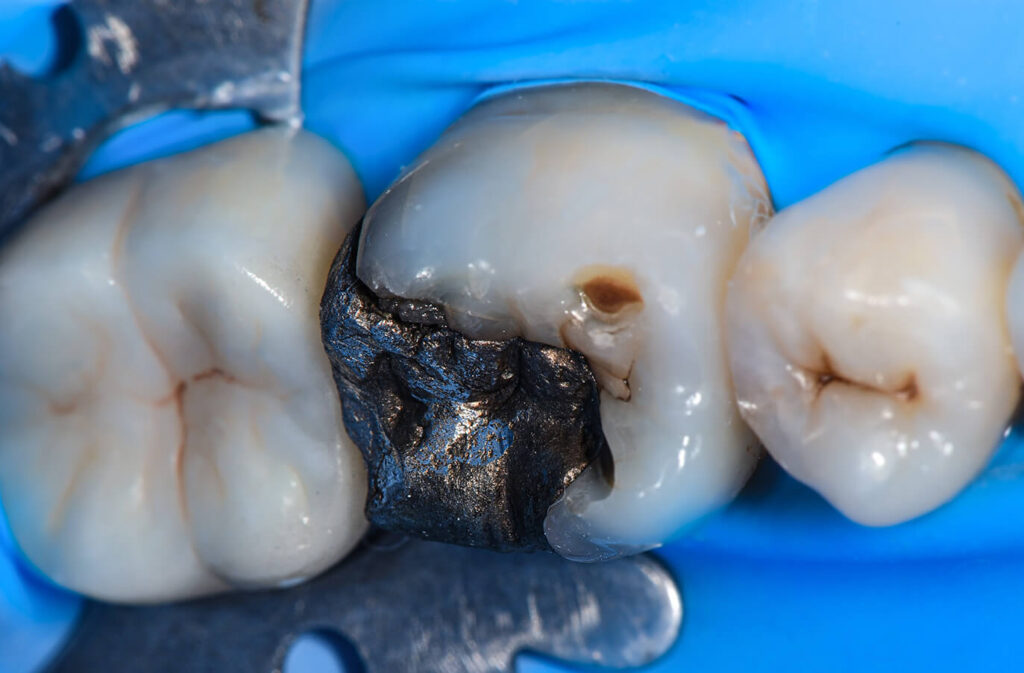Removal of amalgam
Amalgam
Amalgam is a metal alloy that has been used in dental practices for many years to fill cavities in decayed teeth. However, many people are not aware of the toxicity associated with this material.
The primary component of this alloy is mercury (45-50%), which is highly toxic. During chewing, abrasion and wear of the metal material occur, as well as due to salivary acidity, gastric juices, and the increase in temperature during the consumption of hot foods and beverages. All these factors lead to the release of mercury vapors that are absorbed by our bodies day by day, causing harm to our health. In Italy, its use is currently prohibited for individuals under 15 years of age, pregnant or breastfeeding women. (In Sweden, Norway, and Denmark, amalgam is banned!)
Furthermore, especially in cases of extensive dental reconstructions, the use of amalgam weakens the tooth with a high risk of dental fractures. Another side effect is the formation of dark pigmentation on both the tooth and the soft tissues adjacent to the filling.
The removal of amalgam is carried out following a specific protocol, which includes:
- The use of a rubber dam, a sheet of rubber that isolates the work area and prevents accidental ingestion of material fragments.
- High-speed aspiration to limit the inhalation of toxic mercury vapors.
- Protective face shield
- Nasal plugs to filter mercury vapors.
- Individual protections for clothing and hair.
- Mercury detoxification treatment.
Amalgam intoxication can manifest through a series of symptoms, including fatigue, headaches, memory problems, irritability, chemical sensitivity, sleep disturbances, and more. These symptoms may result from exposure to metals present in dental amalgam, such as mercury.
During the removal process, precautions are taken for the safe removal of amalgam to minimize exposure to mercury vapors and protect both the patient and medical staff. This includes the use of protective shields, high-power suction, and the use of protective barriers. Homeopathic treatments are always administered before and after the removal of these metals.
The duration of the amalgam removal procedure can vary from one session to multiple sessions, depending on the amount of amalgam to be removed and the individual conditions of the patient.
Presence of Mercury
The presence of mercury in our mouth can lead to intoxication in our body. For this reason, we provide the patient with a drainage program to be implemented both before and after the removal of amalgam. Additionally, we recommend a detoxifying dietary regimen, reducing gluten, coffee, milk, and dairy products, and not less important, the intake of dietary supplements.
Today, in place of amalgam, new photo-hardened composite resin materials are used, which are not only biocompatible but also provide excellent aesthetics and preserve much more of the healthy tooth structure.
Dr. Pier Carlo Frabboni’s practice follows precise protocols to perform removal procedures for old metal amalgams and uses
composite or ceramic materials with high aesthetic value (metal-free) after replacing the amalgams.
Composite materials perfectly match the color and brightness of natural teeth.
Patients who can undergo this type of treatment are those who:
- Have discolorations on their teeth
- Have silver amalgam fillings
- Need restorations for decayed teeth
- Desire a non-invasive and aesthetic treatment
- Have allergies to metals in the mouth or elsewhere in the body
- Have chronic conditions
- Experience symptoms related to mercury or other metal toxicity.


